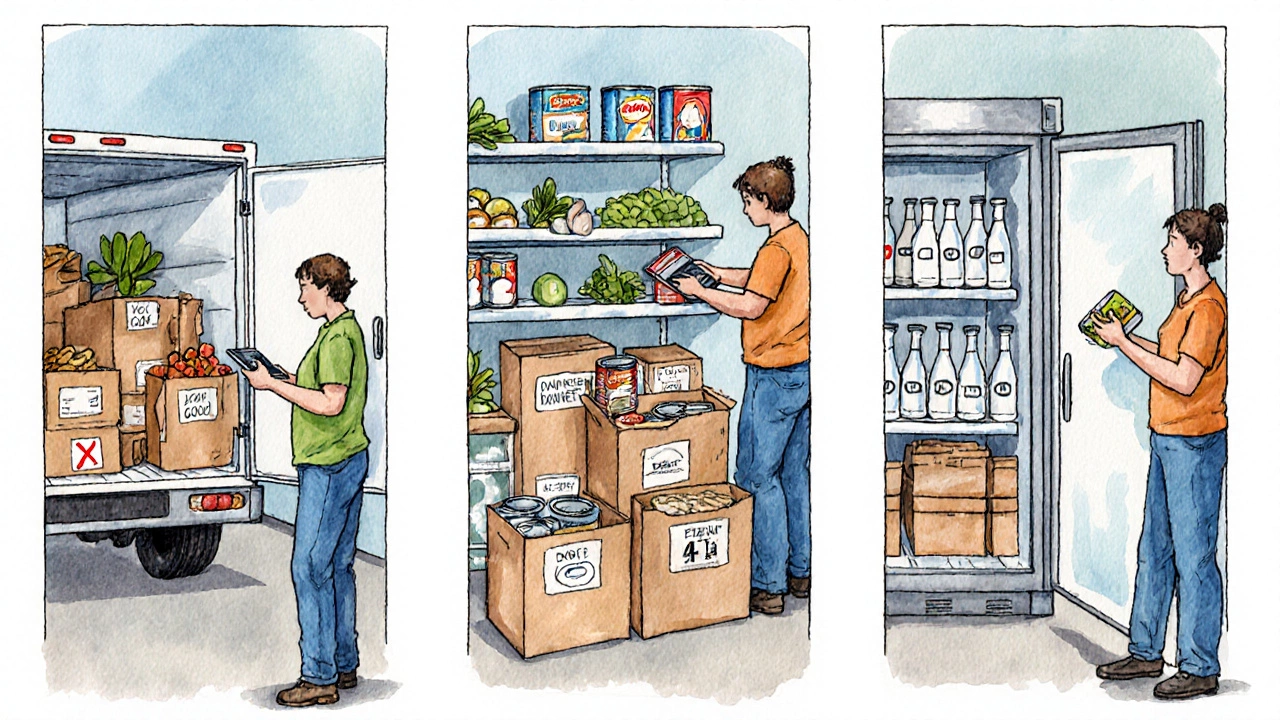How Your Local Food Pantry Operates - A Simple Guide
 Oct, 16 2025
Oct, 16 2025
Pantry Impact Calculator
Contribute Your Resources
How It Works
1 serving = 1 meal
Dry goods: 1 can = 1 meal
Fresh produce: 1 lb = 2 meals
Volunteer hours: 1 hour = 20 meals
When you walk into a Food Pantry is a community‑based distribution point that provides free groceries to people in need, you might wonder what happens behind the scenes. Is there a secret formula? How do volunteers know what to hand out? And why does a local pantry seem to have a limited selection compared to a supermarket? This guide pulls back the curtain on the everyday mechanics of a neighborhood pantry, from the way donations flow in to the moment a family leaves with a bag of fresh produce.
What Exactly Is a Food Pantry?
A food pantry is a local arm of the larger Food Bank that collects, stores, and redistributes donated food to community organizations. While a food bank operates on a regional or national scale, a pantry sits right in your neighborhood, often run by a nonprofit, church, or civic group. Its primary mission is to bridge the gap between available food resources and families facing food insecurity.
How Food Gets to the Pantry
Most pantries receive food through three main streams:
- Wholesale donations from the food bank’s central warehouse. These are usually bulk items like canned beans, rice, and frozen entrees.
- Community donations from local grocery stores, restaurants, and farmers markets. Fresh produce, dairy, and bakery items often flow this way.
- Individual contributions of non‑perishable goods from neighborhood residents.
Every donation is logged into an Inventory Management System that tracks quantity, expiration dates, and nutritional categories. This digital record helps pantry staff forecast needs, avoid waste, and keep shelves stocked with balanced meals.
Sorting, Storing, and Safety Checks
Once food arrives, volunteers sort it into categories: dry goods, canned goods, fresh produce, dairy, and frozen items. A quick safety check follows - any damaged packaging, expired dates, or signs of spoilage result in the item being discarded or returned to the donor.
Proper storage is crucial. Dry goods go on shelves, canned items on lower racks, and fresh produce into refrigerated units set at 40°F (4°C). Freezers stay at 0°F (-18°C). Volunteers rotate stock using the “first‑in, first‑out” rule to keep older items moving forward.
Who Can Get Help? Eligibility Criteria
Most pantries use a low‑barrier approach: anyone in need can walk in, but many require a quick eligibility check to prioritize resources. Common criteria include:
- Proof of residence in the service area (utility bill, lease, or ID).
- Household size and income level - often under 200% of the federal poverty line.
- Special circumstances such as disability, senior status, or recent unemployment.
Some pantries partner with local social service agencies to verify information, while others operate on an honor system. The goal is to be welcoming while ensuring the right families receive help.

Distribution Process - From Shelf to Bag
When a family arrives, the process usually follows these steps:
- Check‑in: A volunteer greets the client, verifies eligibility, and records the visit.
- Needs assessment: The client selects items based on a brief survey about dietary restrictions, children’s ages, and preferred foods.
- Bagging: Volunteers assist in packing balanced boxes - typically a mix of proteins, grains, fruits, and vegetables.
- Education: Many pantries hand out recipe cards or nutrition tips to promote healthy cooking.
- Check‑out: The client signs a receipt for inventory tracking and may be invited to volunteer next time.
This flow ensures that each visit is quick, respectful, and meets nutritional standards.
The Role of Volunteers
Volunteers are the lifeblood of a pantry. Their responsibilities range from sorting donations to managing the front desk. Typical volunteer shifts are 3‑4 hours, and most pantries offer flexible schedules. Training usually covers food safety, client confidentiality, and basic inventory software.
Beyond hands‑on work, volunteers often become community ambassadors, spreading the word to potential donors and new clients. Their feedback can drive improvements, like adding a fresh meat freezer or extending distribution hours on weekends.
Community Partnerships and Funding
Operating a pantry isn’t free. Funding comes from a mix of sources:
- Grants from government agencies or private foundations.
- Fundraising events - soup kitchens, bake sales, or charity runs.
- Corporate sponsorships - grocery chains may donate surplus stock or sponsor refrigeration units.
Partnerships with local schools, senior centers, and health clinics also expand a pantry’s reach. For example, a senior center might host a weekly “Senior Lunch” that uses pantry‑provided meals, while a health clinic can offer nutrition counseling on pantry grounds.
Measuring Impact
Pantries track several metrics to gauge success:
| Metric | Typical Target | Why It Matters |
|---|---|---|
| Households Served | 200‑300 per month | Shows community reach |
| Meals Provided | 5,000 per month | Direct impact on nutrition |
| Food Waste Rate | Less than 5% | Efficiency and sustainability |
| Volunteer Hours | 1,200 per month | Community engagement level |
Data from these indicators informs grant applications, donor reports, and internal improvements.
Common Challenges and How Pantries Overcome Them
Challenge 1: Inconsistent Donation Flow - Seasonal spikes can leave shelves empty in winter. Solution: Build a buffer stock during surplus months and partner with local farms for winter produce programs.
Challenge 2: Limited Refrigerated Space - Fresh items spoil quickly. Solution: Apply for grants specifically earmarked for refrigeration upgrades or run “Cold‑Chain” donation drives with grocery partners.
Challenge 3: Stigma - Some families avoid pantries due to embarrassment. Solution: Create a welcoming environment with dignity‑focused staff training and discreet check‑in areas.
Getting Involved - Your Next Steps
If you’re curious about how your local pantry works, here’s a quick checklist:
- Visit the pantry’s website or Facebook page to learn hours and eligibility.
- Sign up for a volunteer orientation - most organizations need a short background check.
- Donate non‑perishables - check their preferred items list to avoid excess.
- Spread the word - tell neighbors, post on community boards, or host a donation drive.
Even a single hour of your time can keep the shelves stocked and the community healthier.
Frequently Asked Questions
Do I need proof of income to receive food?
Most pantries use a low‑barrier policy, so proof of income isn’t always required. However, some programs may ask for a simple document to verify residency or household size.
Can I volunteer if I have no prior experience?
Absolutely. Training is provided on the day of your first shift. Many volunteers start with simple tasks like unloading boxes or sorting canned goods.
What types of food are most needed?
Fresh fruits and vegetables, dairy, and protein items (meat, beans, eggs) are high priority, especially for families with children.
How often can I receive assistance?
It varies by pantry. Some operate weekly, others bi‑weekly. Check the specific schedule of your local pantry.
Can I donate money instead of food?
Yes. Monetary donations help cover storage costs, refrigeration, and transportation. Most pantries list a donation portal on their website.
